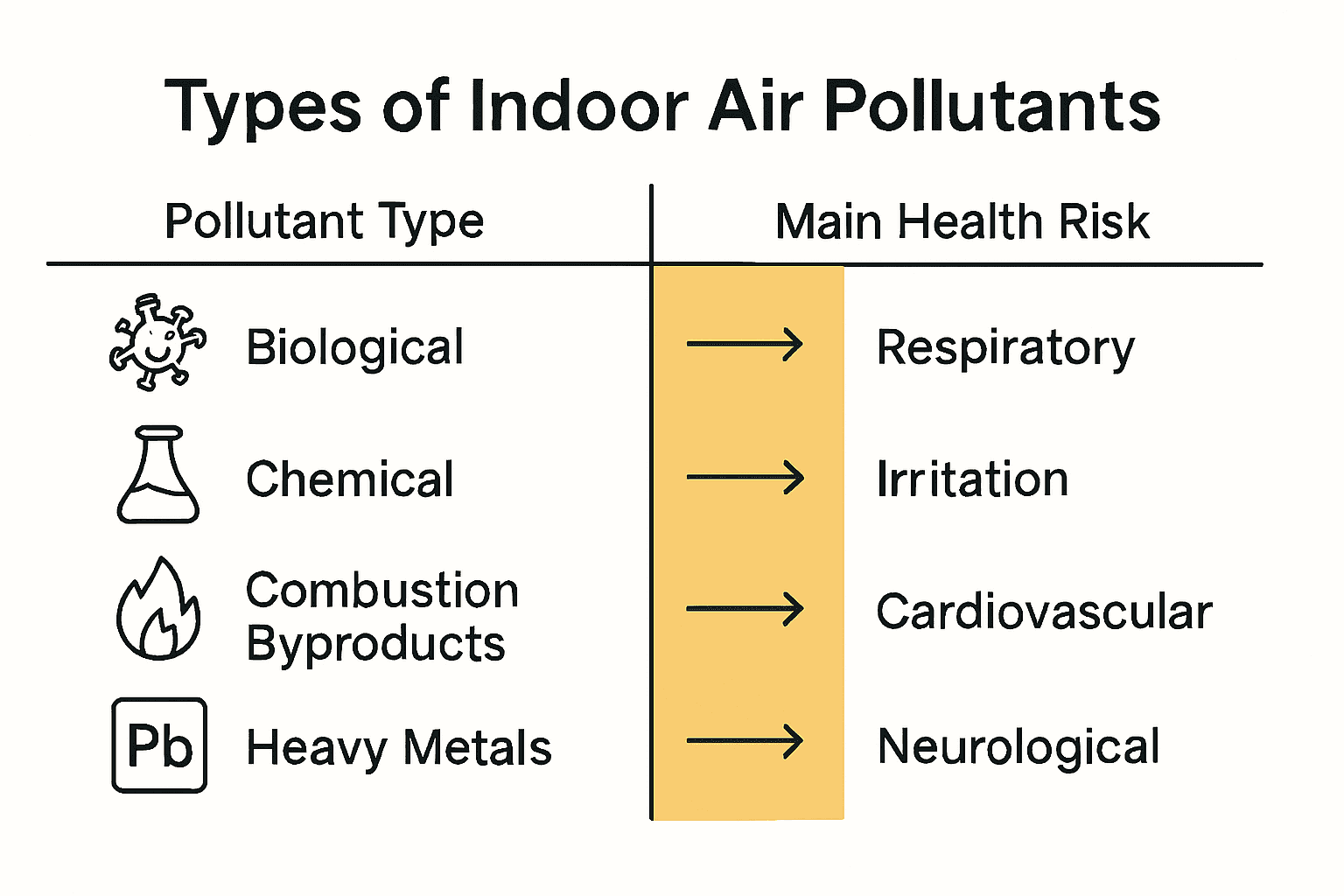Blog sidebar
Category
Recent Posts
- Dec 27, 2025
- Dec 24, 2025
- Dec 21, 2025
- Dec 19, 2025

The Essential Guide to Monitoring Indoor Air Quality
Contents
Did you know the average person spends about 90 percent of their life indoors? The air we breathe inside our homes and workplaces carries a hidden mix of pollutants that can quietly influence our comfort and long-term health. Understanding what is really floating in that invisible atmosphere is key to making our indoor spaces safer, healthier, and more comfortable for everyone.
Key Takeaways
| Point | Details |
|---|---|
| Indoor Air Quality (IAQ) Monitoring | Systematic measurement of pollutants in indoor environments is essential for health and well-being, as humans spend about 90% of their time indoors. |
| Common Pollutants | Key indoor pollutants include VOCs, mold, and combustion byproducts, which can lead to serious health effects, including respiratory issues and cancer risks. |
| Health Risks | Poor IAQ can cause immediate symptoms such as headaches and irritation, as well as long-term issues like respiratory diseases and decreased cognitive function. |
| Improvement Strategies | Enhancing IAQ involves controlling sources of pollution, improving ventilation, and using effective air filtration systems to create healthier living spaces. |
What Is Indoor Air Quality Monitoring?
Indoor air quality (IAQ) monitoring is the systematic process of measuring and tracking pollutants and environmental conditions within enclosed spaces where people spend significant time. Indoor air quality encompasses the invisible atmosphere surrounding us in homes, offices, schools, and other interior environments, directly impacting our health, comfort, and overall well-being.
According to the National Institute of Environmental Health Sciences, environmental health researchers focus on IAQ because humans typically spend approximately 90% of their time indoors. The monitoring process involves comprehensive tracking of various potential contaminants, including:
- Secondhand tobacco smoke
- Combustion byproducts
- Radon gas
- Mold spores
- Volatile organic compounds (VOCs)
- Carbon dioxide levels
- Fine particulate matter
Modern IAQ monitoring goes beyond simple measurement. It involves understanding how different factors like ventilation, temperature, and humidity interact to influence air quality. As research from environmental health studies indicates, indoor pollutant concentrations can be significantly driven by seemingly innocuous sources such as:
- Household cleaning products
- Paint and building materials
- Furniture and furnishings
- Personal care products
- Electronic devices
By implementing systematic monitoring techniques, individuals can gain crucial insights into their indoor environment, enabling proactive steps to reduce potential health risks and create healthier living spaces.
Common Indoor Air Pollutants Explained
Indoor air pollutants are microscopic substances that can contaminate our living spaces, often invisible but potentially harmful to human health. According to the United States Environmental Protection Agency, these contaminants emerge from a wide range of sources within our homes and workplaces, spanning building materials, everyday household items, and combustion processes.
The most prevalent indoor air pollutants include:
- Biological contaminants: Mold, bacteria, viruses, pet dander, dust mites
- Chemical pollutants: Volatile organic compounds (VOCs), formaldehyde, pesticides
- Combustion byproducts: Carbon monoxide, nitrogen dioxide, wood smoke
- Heavy metals: Lead particles, asbestos
IQAir research highlights that these pollutants can originate from surprisingly common sources. For instance, nitrogen dioxide frequently emerges from unvented gas heaters and cooking stoves, while VOCs are released from paints, adhesives, furniture, and cleaning products. Formaldehyde, another significant concern, can be emitted from cabinetry, flooring materials, and various household furnishings.
The potential health implications of prolonged exposure to these pollutants are serious. They can trigger respiratory irritations, exacerbate allergies, cause long-term respiratory problems, and in some cases, increase cancer risks. Understanding the sources and potential impacts of these pollutants is the first step towards creating a healthier indoor environment and protecting your family’s well-being.

Here’s a comparison of common indoor air pollutants, their sources, and potential health impacts:
| Pollutant Type | Common Sources | Potential Health Effects |
|---|---|---|
| Biological | Mould spores Bacteria Pet dander |
Allergies Asthma Respiratory infections |
| Chemical | VOCs from paints Formaldehyde Pesticides |
Eye/nose irritation Headaches Cancer risk |
| Combustion Byproducts | Unvented heaters Cigarette smoke Cooking |
Carbon monoxide poisoning Respiratory issues |
| Heavy Metals | Lead paint Asbestos insulation |
Neurological damage Lung disease |
How Air Quality Monitoring Devices Work
Air quality monitoring devices are sophisticated technological tools designed to detect and measure various environmental parameters within indoor spaces. These intelligent systems leverage advanced sensor technologies to provide real-time insights into the invisible world of airborne contaminants and environmental conditions.
According to recent research from an IoT-based robotic monitoring system, modern air quality monitors typically incorporate multiple specialized sensors capable of tracking critical indicators such as:
- Carbon dioxide (CO₂) levels
- Volatile organic compounds (VOCs)
- Smoke concentration
- Temperature
- Humidity
The core functionality of these devices involves continuous sampling and analysis of indoor air. Sensor technologies range from electrochemical and photoionization detectors to advanced optical and infrared sensing mechanisms. Some cutting-edge systems, like the IoT-based robotic approach, even use mobile platforms to map air quality dynamically across different indoor spaces.
Traditional monitoring methods, such as diffusion tubes, offer alternative approaches for measuring pollutant concentrations. These passive devices collect gas samples over extended periods, providing average pollutant levels useful for comprehensive environmental assessments in spaces like museums, industrial facilities, and residential environments. By transforming invisible air composition into measurable data, these monitoring devices empower individuals to understand and improve their indoor environmental health.
Health Risks of Poor Indoor Air Quality
Indoor air quality is far more than a mere environmental concern—it’s a critical health issue that directly impacts our daily well-being. According to the United States Environmental Protection Agency, exposure to indoor pollutants can trigger both immediate and long-term health consequences that range from mild discomfort to serious medical conditions.
Immediate health effects of poor indoor air quality often manifest as:
- Eye, nose, and throat irritation
- Persistent headaches
- Unexplained dizziness
- Chronic fatigue
- Recurring respiratory infections
Long-term exposure presents even more serious risks. Research on indoor air quality indicates potential connections to severe health conditions including:
- Respiratory diseases
- Cardiovascular complications
- Increased cancer risk
- Compromised immune system function
- Reduced cognitive performance and productivity
Particularly alarming is the impact in low-income regions, where indoor cooking-related pollution contributes to millions of premature deaths annually. The invisible nature of these pollutants makes them particularly dangerous, as individuals may be exposed for extended periods without recognizing the potential health threats.
 Implementing comprehensive air quality monitoring, improving ventilation, and reducing pollution sources are crucial steps in mitigating these significant health risks.
Implementing comprehensive air quality monitoring, improving ventilation, and reducing pollution sources are crucial steps in mitigating these significant health risks.
Improving Air Quality: Best Practices
Enhancing indoor air quality requires a multifaceted approach that addresses pollutant sources, ventilation, and filtration. The United States Environmental Protection Agency recommends three fundamental strategies for creating a healthier indoor environment:
- Source Control: Identify and eliminate or reduce indoor pollution sources
- Ventilation Improvement: Increase air circulation and introduce fresh outdoor air
- Air Filtration: Use high-efficiency air cleaning devices
According to Australian Government Health Guidelines, practical steps to improve indoor air quality include:
- Increase outdoor air flow by regularly opening windows
- Install high-efficiency HEPA air filters
- Avoid indoor combustion activities
- Control indoor moisture levels
- Maintain clean living spaces, especially pet areas
- Use respirators during high pollution periods
- Regularly clean and replace HVAC system filters
Special attention should be paid to specific environments like kitchens, bathrooms, and areas with potential moisture buildup. By implementing these strategies consistently, individuals can significantly reduce indoor air pollutants, creating a healthier living space that supports overall well-being and respiratory health.
Transform Your Home Environment with Stomart’s Smart Solutions
Worried about invisible air pollutants affecting your health and well-being? This guide has highlighted how everyday activities and common items can quietly compromise the quality of the air you breathe indoors. Understanding the dangers of volatile organic compounds, poor ventilation, and lingering allergens is crucial. The next important step is using practical tools and action to create a safer, fresher home for you and your family.
Stomart offers a carefully selected range of home goods and wellness gadgets designed to help you monitor and improve your indoor environment with ease. Explore products that support cleaner air and a more comfortable living space by browsing our latest arrivals. Take control of your indoor air quality today. Visit Stomart.co.uk to discover the essentials you need for healthier living and enjoy promotional deals tailored to your home’s unique needs—shop now and make your well-being a priority.
Frequently Asked Questions
What is indoor air quality monitoring?
Indoor air quality monitoring is the systematic process of measuring and tracking pollutants and environmental conditions within enclosed spaces, aiming to improve health and overall well-being.
What are common indoor air pollutants?
Common indoor air pollutants include biological contaminants (like mold and pet dander), chemical pollutants (such as VOCs and formaldehyde), combustion byproducts (like carbon monoxide), and heavy metals (including lead and asbestos).
How do air quality monitoring devices work?
Air quality monitoring devices use advanced sensor technologies to detect and measure various parameters, including CO₂ levels, VOCs, smoke concentration, temperature, and humidity, providing real-time insights into air quality.
What are the health risks associated with poor indoor air quality?
Poor indoor air quality can lead to immediate health effects like eye irritation and headaches, as well as long-term issues including respiratory diseases, cardiovascular complications, and increased cancer risk.
Recommended
- The Best Indoor Plants for Air Purification: Your Guide to Cleaner Air - STOMART.CO.UK
- The Best Affordable Air Purifiers for Clean Breathing - STOMART.CO.UK
- Why These Home Fragrance Gadgets Are Selling Out Fast - STOMART.CO.UK
- The Benefits of House Plants for Your Home and Health: Bringing Nature - STOMART.CO.UK
- Why Indoor Air Quality Testing Matters for Your Home and Health
- Understanding Why Monitor Indoor Air Quality Matters - Coway Water Purifier
Share
YOU MAY ALSO LIKE
- Dec 27, 2025
- Dec 24, 2025
- Dec 21, 2025
- Dec 19, 2025
- Dec 17, 2025
- Dec 16, 2025
- Dec 15, 2025
- Dec 15, 2025
- Dec 15, 2025
- Dec 11, 2025
- Dec 11, 2025
- Dec 08, 2025
- Dec 05, 2025
- Dec 05, 2025
- Dec 02, 2025
- Dec 01, 2025
- Dec 01, 2025
- Nov 30, 2025
- Nov 30, 2025
- Nov 29, 2025
- Nov 25, 2025
- Nov 24, 2025
- Nov 23, 2025
- Nov 22, 2025
Category
Recent Posts
- Dec 27, 2025
- Dec 24, 2025
- Dec 21, 2025
- Dec 19, 2025



















































